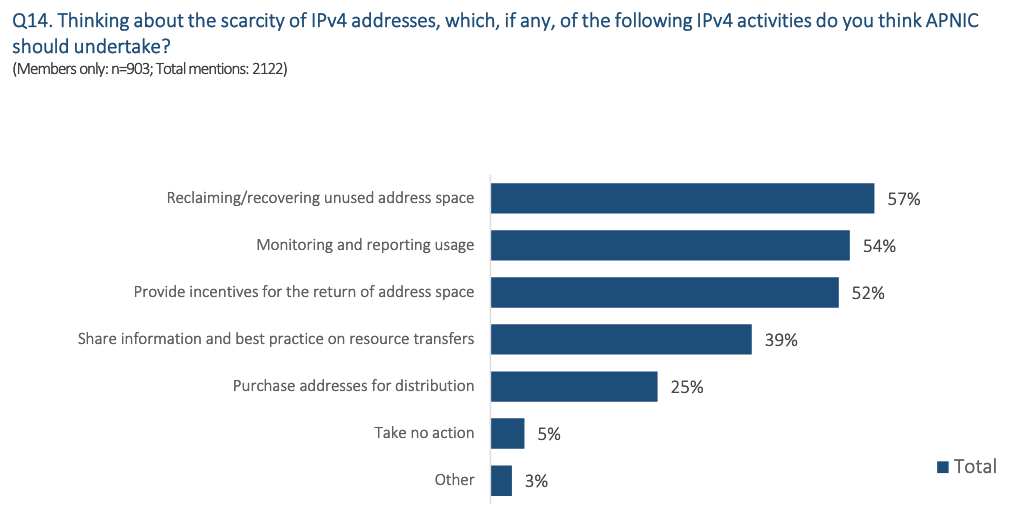
APNIC collects the views of Members and stakeholders through a survey every two years. The survey helps the APNIC Executive Council (EC) and Secretariat to better understand the needs and wishes of the community. The 2020 APNIC Survey will open in a couple of weeks and we look forward to getting your feedback.
One strong message from the 2018 APNIC Survey was that not all organizations are ready to deploy IPv6, therefore, even while promoting IPv6 deployment, APNIC must continue to support access to IPv4 address space. When asked how APNIC can do so (Q14), Members gave the highest priority to the reclamation of unused IPv4 address space.

In response to this feedback, the APNIC EC asked the Secretariat to prioritize work on reclamation of unused IPv4 addresses.
APNIC started this activity in 2019 by defining unused IPv4 addresses as ‘a /24 or more of a delegated prefix that is no longer needed by its registered holder’. To determine if a prefix is no longer needed, APNIC decided it would contact Members who have received IPv4 delegations where at least a /24 or more of their delegated prefix is not visible in the global routing system.
At APNIC 49, APNIC Chief Scientist, Geoff Huston, presented an analysis of routing and addressing in the Internet. He revealed that the global pool of allocated but unadvertised IPv4 address space is around 50 /8s at present, and slowly growing.

In July 2019, APNIC staff analysed the pool of unadvertised IPv4 delegations, and categorized them into groups based on the policy that applies to them.
Addresses delegated under the last /8 policy less than five years ago
Under current APNC policies, addresses delegated under the last /8 policy cannot be transferred for a minimum of five years after the original delegation. During that time, if the reason for the original request is no longer valid, the resources must be returned to APNIC. Around 370,000 unadvertised IPv4 addresses were identified in this category, held by 604 APNIC Members, and APNIC has encouraged those Members to return these addresses if they are not needed.
Addresses delegated under the last /8 policy over five years ago or not delegated under the last /8 policy
These addresses are eligible for transfer under the IPv4 transfer policy or can be returned to the APNIC free pool. To assist Members with IPv4 transfers, a new IPv4 Transfer Listing Service is being developed in MyAPNIC, which will allow Members to list IPv4 prefixes that are available for transfer. APNIC identified around 50 million unadvertised IPv4 addresses in this category (equal to more than three /8s), held by 1,395 APNIC Members, and will start contacting these Members over the next few months once the IPv4 Transfer Listing Service is ready.
Historical address space
‘Historical resources’ are those IPv4 addresses and AS Numbers that were delegated before APNIC existed or had management authority over the resources in question. The policy for historical resources allows the recovery of address space that has been allocated or assigned but not used for a reasonable period of time.
APNIC staff identified around 2.3 million unadvertised historical IPv4 addresses (approximately one /11) and around 1.1 million voluntarily returned historical IPv4 addresses (approximately one /12). APNIC is making another attempt to contact the custodians of the remaining resources to find out if they still need these resources. If the custodians cannot be contacted, the resources will be marked for recovery.
In summary, the unadvertised space may potentially be actioned as follows:
| Delegation time | No of addresses | Potential action |
| Under five years (last /8 policy) | 370,000 | Return to pool |
| Over five years (by APNIC) | 50,000,000 | Return to pool or transfer |
| Historical | 3,400,000 | Return to pool, transfer or manage under APNIC account |
APNIC is aiming to complete these activities by the end of the year and will continue to share progress with the community via the APNIC Blog and at APNIC 50. Any APNIC Members who have questions or queries can contact the Helpdesk for more information.
The views expressed by the authors of this blog are their own and do not necessarily reflect the views of APNIC. Please note a Code of Conduct applies to this blog.

Why care? Start pushing ipv6 already instead of holding on ipv4 for ever
Thanks for the feedback Andrea. We agree IPv6 is indeed the future. There’s a lot of deployment resources available on our dedicated IPv6 pages and APNIC provides online courses, tutorials and training workshops on IPv6.
https://www.apnic.net/ipv6
https://academy.apnic.net/en/catalog/
APNIC also provides technical assistance with IPv6 deployment to a number of our Members.
https://www.apnic.net/community/support/technical-assistance/
The project to reclaim unused IPv4 address space was requested by the community via the APNIC survey. See page 6 of the 2018 Survey report.
https://www.apnic.net/wp-content/uploads/2018/09/2018-APNIC-Member-Survey-Report.pdf
Thanks for reading the blog!